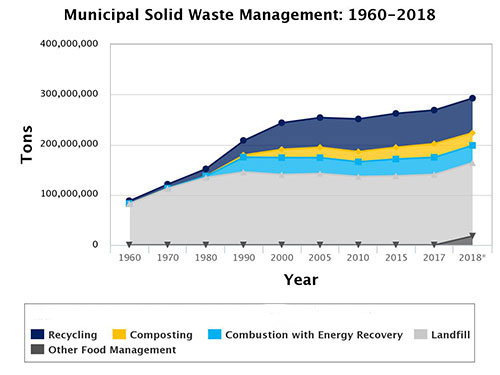Reducing Waste: Solid Waste Management Tips
It's no secret that we generate lot of trash. As of 2018, the average person generates over 4.3 to 4.9 pounds of waste per day, which is 1.6 to 2.2 pounds more than most of us produced in 1960.
Each year, trash is generated in the form of packaging, bottles, boxes, cans, grass clippings, furniture, clothing, and more. Significant energy and resources are consumed in the production, transporting and disposal of this waste stream.
*MSW generation rose considerably from 2017 to 2018 mainly because EPA enhanced its food measurement methodology to more fully account for all the ways wasted food is managed throughout the food system. EPA Facts and Figures about Materials, Waste, and Recycling Webpage
We can significantly reduce the amount of solid waste by following some basic principles of reducing the amount of waste that is created, reusing materials that would otherwise be discarded, by recycling materials and by using recycled materials. The commonly-used "3-R" phrase to describe this principle is: "Reduce, Reuse, and Recycle".
Reduce
- Take reusable bags to the grocery store instead of single-use plastic bags.
- Select items with limited or no packaging.
- Use a refillable container for water in place of bottled water.
- Reduce "junk mail". According to Donotmail.org, direct mail creates 10 billion pounds of solid waste each year, and approximately 44 percent of junk mail goes to landfills unopened. Sadsbury Township offers instructions on how to receive less junk mail with a Junk Mail Reduction Kit. The Junk Mail Reduction Kit is a brochure that includes tear-off postcards to fill out, which will remove your name from the mailing lists of the nation's four largest direct mail advertisers. It also provides the toll-free phone numbers of five of the biggest data-compiling companies who sell names and addresses to marketers.
- Think twice before printing material from the internet. When possible, print on both sides of the paper.
- Set a goal for reducing the amount of trash generated each week.
- Recycle paper and cardboard. The University of Utah estimates that cardboard and paper waste make up 41% of the municipal solid waste stream. Recycling cardboard takes 24% less energy and produces 50% less sulfur dioxide than making cardboard from raw materials.
Reuse
- Think of ways to use packaging materials and ways to reuse items that no longer serve their function.
- Use cloth napkins and plates instead of paper.
- Shred or compost untreated wood and leaf wastes into chips and use them as mulch on garden beds to prevent weed growth, retain moisture, regulate soil temperature, and add nutrients back to the soil.
- Have a yard sale to find new homes for clothes, toys, appliances, books, and other items.
- If you are remodeling, donate old cabinets, doors, fixtures and hardware to local charity centers, such as Habitat for Humanity's "Re-Store".
- For useful items that you no longer want but do not want to throw away, consider the Freecycle Network, which provides options for participants to give away or trade items.
Recycle/Compost
- Make it a habit to separate out all items that are recyclable.
- Raise the cutting height of your lawn mower during the hot summer months to keep grass roots shaded and cooler. This reduces weed growth, browning, and the need for watering.
- When you mow, leave grass clippings on your lawn instead of bagging them or use a mulching mower. The clippings will return nutrients to the soil instead of taking up space in landfills.
- Check with local repair shops to see if they can use your old appliances for spare parts.
- Use food scraps, yard trimmings, and other organic waste to create a compost pile that can help increase water retention, decrease erosion, and replace chemical fertilizers.
- Buy recycled-content gardening equipment and tools, such as garden hoses made from old tires, stepping stones made from old glass bottles, or hand tools made with recycled plastic. You can also find composite lumber made from recycled plastic bottles and bags.
- Recycle hazardous waste during periodic hazardous waste collection programs.


